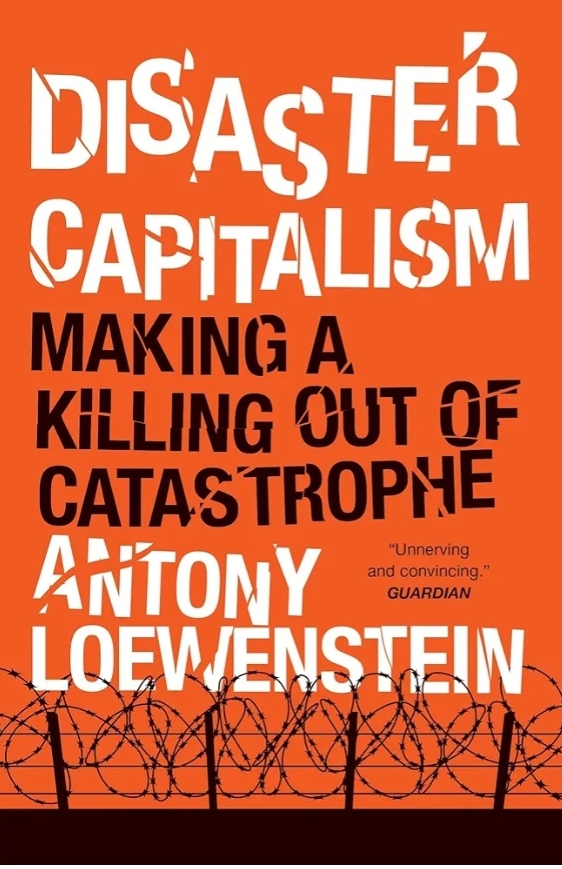Introduction
In Disaster Capitalism: Making a Killing Out of Catastrophe, Antony Loewenstein exposes a disturbing truth: in the modern global economy, war, disaster, and crisis are not simply unfortunate events—they are lucrative business opportunities for corporations, private contractors, and even governments. Far from alleviating suffering, the systems set up to manage disaster often deepen inequality and fuel cycles of exploitation.
What is Disaster Capitalism?
Loewenstein’s concept of “disaster capitalism” builds on Naomi Klein’s The Shock Doctrine, arguing that the world’s most vulnerable are targeted by a global industry that profits from chaos. When natural disasters, wars, or economic collapses strike, a web of private companies swoops in—not primarily to help, but to extract maximum profit.
Key Features of Disaster Capitalism:
- Privatization of Aid: Humanitarian work, refugee camps, and disaster zones are increasingly managed by for-profit companies rather than NGOs or governments.
- Perpetual War Economy: Ongoing conflicts (Iraq, Afghanistan) become self-sustaining markets for security firms, construction giants, and arms manufacturers.
- Refugee Industry: Detention centers, border security, and migrant management are run by corporations making billions from misery.
- Aid as Leverage: Economic “aid” and reconstruction are often tied to contracts and conditions that funnel wealth back to Western firms, not local populations.
- Legal and Ethical Gray Zones: In the chaos of disaster, oversight and accountability break down, allowing rampant corruption, abuse, and human rights violations.
Case Studies and Examples
Loewenstein documents disaster capitalism in action around the world:
- Afghanistan and Iraq: Billions spent on reconstruction vanish into the coffers of contractors like Halliburton and DynCorp, with little improvement for ordinary citizens.
- Haiti: After the 2010 earthquake, promised rebuilding funds mostly benefited foreign consultants and firms, while most Haitians remained in dire poverty.
- Australia & the U.S.: For-profit detention centers (run by companies like Serco and GEO Group) profit from locking up refugees and immigrants, with little incentive to improve conditions or find humane solutions.
- Greece: The economic collapse enabled international creditors and corporations to privatize public services and infrastructure at fire-sale prices.
Who Benefits?
Disaster capitalism is not an accident—it is a system. The primary beneficiaries are:
- Multinational Corporations: Construction, security, healthcare, and logistics companies win enormous contracts.
- Private Military and Security Firms: Grow rich on endless wars and instability.
- Political Elites: Receive campaign donations, revolving-door jobs, and international clout.
- Banks and Creditors: Collect interest and impose “structural adjustments” that open new markets for privatization.
The losers are almost always local populations, whose suffering becomes a business model.
The Mechanism: How Disaster Becomes Opportunity
Disasters—natural or man-made—produce a state of emergency. In the confusion, rules are suspended, oversight weakens, and speed is prioritized over scrutiny. Governments and aid agencies turn to the private sector for rapid solutions, often bypassing transparency and public debate. “Rebuilding” then means outsourcing everything from prisons and schools to basic infrastructure, frequently locking countries into cycles of debt and dependency.
The Broader Pattern: Empire and Managed Crisis
Loewenstein shows how disaster capitalism is not just a byproduct of neoliberal economics, but a deliberate strategy by powerful nations and global capital. Manufactured or opportunistically exploited crises become the new frontier for extraction, reminiscent of what the Report from Iron Mountain and thinkers like John Perkins (Confessions of an Economic Hit Man) described as a world managed by perpetual emergencies—where every crisis is a chance for profit.
Implications: Beyond Humanitarianism
Loewenstein’s warning is stark: so long as profit is prioritized over people, disasters will be seen as opportunities, not tragedies. The business of catastrophe reshapes laws, undermines democracy, and ensures that the poor and vulnerable stay that way.
Solutions and Resistance:
- Transparency and Accountability: Demand public scrutiny of all disaster contracts and aid flows.
- Rebuild Public Sector Capacity: Empower local governments and communities, not just foreign contractors.
- International Regulation: Global standards and oversight for disaster response industries.
- Grassroots Activism: Support organizations that resist privatization and promote genuine recovery.
Conclusion
Disaster Capitalism pulls back the curtain on the dark intersection of profit and suffering. By exposing how the powerful use catastrophe as a business plan, Loewenstein urges citizens to demand a new kind of response—one that puts humanity before the bottom line, and builds real resilience instead of exploiting pain.







